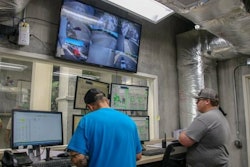
Hopefully, the title of this column caught your eye! No, body doubling is not some sci-fi fantasy or astrophysicist explanation of the theory of multiverses, but it is “a thing.”
What is body doubling?
Body doubling is a technique where you work in another person's physical or virtual presence. The idea (and actual results for many people who utilize it) is that it will make you less alone, more focused … and more accountable for both starting and finishing important and sometimes onerous or difficult tasks or projects.
This technique started as a strategy to assist people with ADHD to stay focused on a job, and today many career and business coaches utilize it with their clients for some of the same reasons. Below, we look at the concept, how to implement it in the grain industry, and some of the benefits of using this unique approach.
Why does body doubling work?
Many managers like to think of themselves as strong, independent types in little need of assistance or help.
However, we would argue that there are times when you might benefit from some hybrid vigor – the biological concept in both crops and livestock - that the offspring of a mating shows stronger characteristics (size, growth rate, fertility and yield) over those of its parents.
This “hybrid vigor” can come from seeking help or assistance from others – even if they are present or willing to hold you accountable (see Ask for Accountability sidebar).
Deborah Grayson Riegel, an Instructor in Leadership Communication at the Wharton Business School, discusses when you might want to call in a double, in her book: Go to Help: 31 Strategies to Offer, Ask For, and Accept Help.
She explains that you may want additional support, if you are experiencing any of what she calls the 5 Rs:
- Resistance to starting a task or a project (or finishing one)
- Reluctance to continue the work
- Restlessness leads to difficulty focusing or concentrating
- Rumination about challenges, obstacles, setbacks, decisions or next steps
- Readiness, but you just are not tackling the task for some other reason
Riegel argues that this body doubling creates engagement, reduces resistance, increases motivation, and decreases isolation.
We have also recommended a similar concept to others, both in academia and agri-business — that committing to someone else (your spouse, a critical assistant manager in your feed and grain business, or a trusted friend) is like making a pact or promise to that person that you will complete a task or project — and this act often increases your chances of accomplishing what you have shared with this person.
How to implement the Body Double Technique
1. Set up a block of time.
Start by setting up a specific time for you and your chosen colleague (or other person selected for this task) to work simultaneously on projects that you each have.
“To be clear, these are not tasks that require collaboration, nor do they all have to be the same task,” Riegel states. For example, you might be working on employee evaluations while your colleague updates a database. You could do this together in a conference room or virtually by utilizing video calling programs.
2. Develop some guidelines
This part of the plan involves setting some guidelines with your partner to make this a positive experience. Such parameters might include:
- Can you ask each other for advice or a pep talk?
- If you notice your partner losing enthusiasm, should you mention it?
- If something urgent comes up, how will you handle this?
- When will you take breaks?
- Are you working in silence, or can you engage in polite chatting?
When you start the process, each partner should share what they intend to accomplish and how they “want to feel” at the end of your session.
3. Share the results
At the end of your appointed time together — each participant should share what they accomplished and how they feel about the experience. Then, you should thank your partner and decide if you want to do this again in the future.
Some may feel that this approach might be too “touchy-feely” for them. However, our comment here would be — “it’s only crazy if it doesn’t work.” Given some of the recent challenges and negative impacts we have all faced with the COVID pandemic — perhaps you want to take a risk and try this technique.
Productivity benefits of body doubling
Practitioners have found that the body doubling technique can have numerous benefits. Riegel has found that it lessens feelings of isolation since you are in someone else's presence (physical or virtual).
Additionally, it can decrease procrastination, and as we mentioned in our introduction — it can increase your accountability. Potentially, you may learn more effective ways of working by observing your body double!
Indeed, if the process works — you will have feelings of confidence and competence. And — Riegel shares that potentially you may find that you accomplished more than you intended.
Similar and complementary management approaches
Let’s face it. We are all challenged by the need for inspiration, motivation, encouragement and accountability. You may already be involved in one or more of the following: working with a mentor; being a member of a business networking group; participating in retreats; or regular breakfast/lunch professional group.
Note that as a business leader, you are not alone. People from the creative communities (writers, actors, visual artists and musicians) use all of these techniques regularly, as well as many other groups.
There are some key “take-aways” that participants experience. Inspiration and motivation for some people come on their own, but we need other people to promote inspiration and motivation for most of us.
Accountability is another outcome that most often requires other people. Often people will meet a deadline for someone else before they will meet it for themselves. Another phrase that you might hear associated with these topics is “Just Do It.”
Mental blocks and procrastination can often be overcome when you sit down and “do it” – whether it is creating the list of new customer contacts for the marketing team, developing the new section of the employee policy handbook, researching new programs to update your computer system, etc. — often just getting started is the most significant step. The Body Doubling approach can be a practical approach here.
Give body doubling a shot
Like the old Life® cereal commercial (if you are old enough to remember it), where his older brother give Mikey the cereal as they are not sure if they will like it – and voila “He Likes it!”
You may find that utilizing the “Body Double” concept is worth a try a couple of times a year.
Specifically, as mentioned above – the technique can be helpful for jobs or projects that you have a hard time starting – or completing. We all need some encouragement at times, and this technique might be just the ticket.
Ask for Accountability
Rick Randolph of Forging Leaders discusses giving others permission to hold you accountable as a way of telling them you value their feedback and reinforcing how important a particular goal is to you.
[Deleted He says] Asking for accountability does four things:
- It demonstrates that leaders are fallible, but through intentional practice we can change.
- It teaches your employees that they are part of the team, and as a result have the right to ask you as manager for accountability.
- It reinforces the commitment to the goal you have set – even when no one notices.
- It shows accountability not as a negative, but as a way to progress toward a goal.
While it certainly takes a humble leader or manager to ask for accountability in this way, it can be a great strategy to show trust in your team and to help you stay on track related to a specific project or goal.
Use an Accountability Partner
This concept is a cousin of the body double process we have described in this column. However, it operates on a somewhat different level.
ActionBuddy defines an accountability partner as someone with whom you establish an ongoing, reciprocal relationship where each partner commits to coach the other towards achieving their goals and to be held accountable for their progress towards their own goals. The relationship should be based on trust and commitment where you each coach and support each other.


















